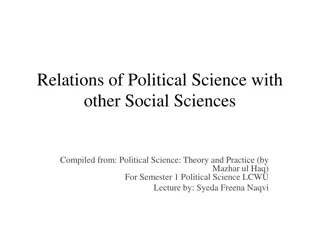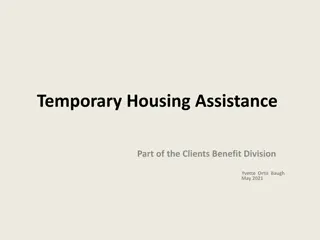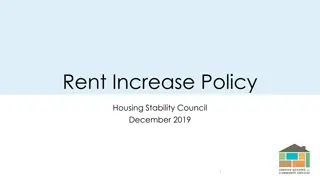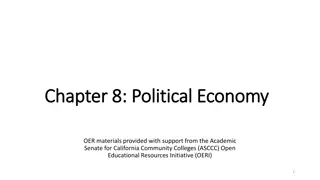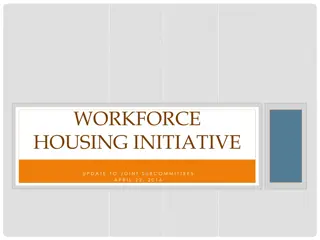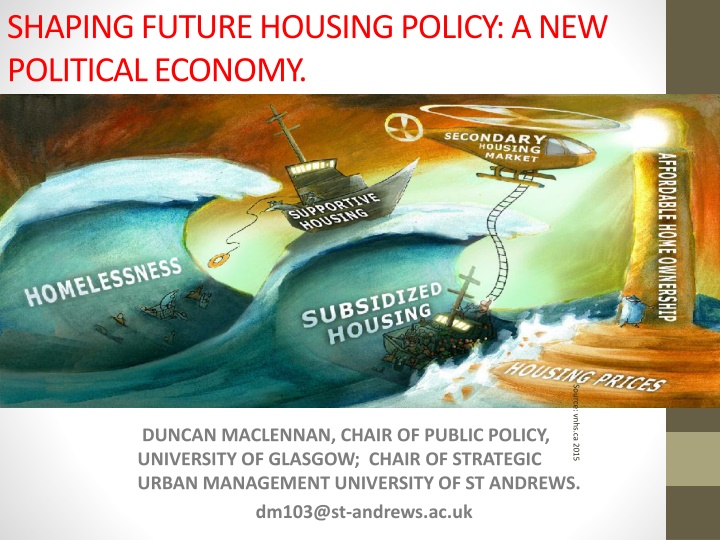
Shaping Future Housing Policy: A New Political Economy Overview
Explore the rethinking of housing policies for big outcomes in the changing context and consequences of the housing sector. Understand the significance of housing outcomes and how they impact productivity, wellbeing, and economic systems.
Download Presentation

Please find below an Image/Link to download the presentation.
The content on the website is provided AS IS for your information and personal use only. It may not be sold, licensed, or shared on other websites without obtaining consent from the author. If you encounter any issues during the download, it is possible that the publisher has removed the file from their server.
You are allowed to download the files provided on this website for personal or commercial use, subject to the condition that they are used lawfully. All files are the property of their respective owners.
The content on the website is provided AS IS for your information and personal use only. It may not be sold, licensed, or shared on other websites without obtaining consent from the author.
E N D
Presentation Transcript
SHAPING FUTURE HOUSING POLICY: A NEW POLITICAL ECONOMY. Source: vnhs.ca 2015 DUNCAN MACLENNAN, CHAIR OF PUBLIC POLICY, UNIVERSITY OF GLASGOW; CHAIR OF STRATEGIC URBAN MANAGEMENT UNIVERSITY OF ST ANDREWS. dm103@st-andrews.ac.uk
OUTLINE 1. Rethinking Housing, Systems and Outcomes 2. Changing Context and Consequences 3. The New Context 4. Principles for Policies
1. Housing Policies, Big Outcomes POLICIES FOR HOUSING ACROSS THE OECD NOW Expenditures cut Taxation unreformed Planning critiqued Downloading to provinces, states and national withdrawal Cut down scope to homelessness and the poorest AT A TIME WHEN Housing needs estimates rising, affordability falling AND EXACERBATING POOR BIG OUTCOMES Environmental footprints rising Inequality increasing Productivity flat/ Falling and instability Issues WE NEED A NEW PERSPECTIVE, NEW EMPHASIS, THAT IS MORE THAN POVERTY, SHELTER AND POVERTY
1. Housing: a Key Economic System A geographically fixed, durable asset with multiple attributes that shape different housing services . These includes shelter and space to live Shapes access to employment and sites the family uses Neighbourhood, locus for services, amenities, social contact The home is an asset and a source of debt Homes connect us to our past and shape paths to future The home becoming a wired hub for household activities well beyond the neighbourhood into the global. ECONOMIC, SOCIAL AND ENVIRONMENTAL INFRASTRUCTURE
1. Housing Outcomes Understanding housing system significance: housing outcomes Comprise significant share of household budgets (macro) Housing loan/asset, finance (macro) roles Housing (size, quality) impacts human/business capital Location choices have spillover effects (metro, emergent) neighbourhood choices impact human/business capital Prices/rents ( net wealth) impact mobility, wealth, savings, investment, welfare and social mobility. AND HOUSING PROCESSES MATTER TOO Planning and Design, Construction, Financing, Selling etc
1. Nature of Housing Leads to Policy Neglect 1. Capital intensive, often wish to postpone support 2. Multiple small joint effects 3. Extensive spillovers. 4. Micro, metro, macro impacts and interests: multi- perspective 5. Multiple levels of Government as well as multiple portfolios: Local, metropolitan becoming critical level. SHAPES A COMPLEX POLITICAL ECONOMY OF BUREAUCRACIES, LOBBIES, MULTIPLE INTERESTS NOW FAILING TO GET TRACTION. HOW DIS WE GET HERE? HOW, WHY SHOULD WE CHANGE THIS
2. POLICY CONTEXT: OECD AFTER 1995 After 1995, two different decades, Long boom (until 2007) Rising real middle/ upper incomes, grows ownership Facilitated by mortgage market deregulation; overall rate boosted by ageing population (important e.g Canada, UK) Wage inequality increases rental pressure for poor and young: origins of Generation Rent (housing, pensions, education and environment) Housing Policy communalities (Washington consensus) Public housing hits the wall: Selling,Transferring, reduced investing Promotion of different approaches to affordable (owning, non-profit) Emphasis on ownership growth but age specific rates already falling Public capital on housing, and sometimes supporting infrastructure reduced Switch from dwelling to person subsidies,new concerns about welfare budgets Value of implicit tax subsidies rises:Inattention to supply side policies HOUSING POLICIES LOST TRACTION (EXCEPTIONS)
2. HOUSING POLICY, GLOBAL CONSEQUENCES Broad (Housing Policy) Shifts of Long Boom Increased domestic cyclical instabilities Underpinned, directly, the GFC and The immediate downturn The subsequent recessions New austerity anti-public debt culture Increase income and wealth inequality (Generation Austerity) Facilitated rentier economies (Generation Rentier) Created a political economy dominated by home owners, elderly, suburbs rather than city cores, renters and the poor.
2. Wider Policy Outcomes POLICY AIMED AT MAXIMISING OWNERSHIP RATHER THAN EFFICIENCY. OUTCOMES? AN ARGUMENT: Financial deregulation, unreconstructed planning ystems Demand not supply emphasis raises real house prices, taxes capitalised Increased cyclical instability (boom and bust) Subsidy inequality raises housing wealth inequalities and disposable income inequality: intergenerational issues Has arguably lowered productivity and facilitated a rentier economy (Piketty)
2. CORE ISSUE PROPOSITION WE ARE DEALING WITH REAL HOUSE PRICE INCREASES UNRELATED TO PRODUCTIVITY GAINS. THIS IS A CENTRAL POLICY PROBLEM OF THE OECD ECONOMIES SIMILAR TO THE WAGE INFLATION CRISES OF THE 1970 S. GOVERNMENTS FIDDLE WITH AFFORDABILITY AND HOMELESSNESS SYMPTOMS WHEN THIS HOUSE PRICES ARE THE CRITICAL, DIFFICULT ISSUE OF THE TIMES. KEY HOUSING MARKET OUTCOME DISTORTS THE ECONOMY REDUCING PRODUCTIVITY AND INCREASING INEQUALITY. HOUSING POLICIES SHOULD BE ABOUT REDUCING INEQUALITIES AND RAISING PRODUCTIVITY, NOT VICE VERSA. LET US ASSESS, IN CANADIAN CONTEXT. HOW SHOULD WE THINK ABOUT HOUSING CAPITAL?
3. Housing Capital in the 21st Century Piketty (2014) a starting point Empirical, rising income and wealth inequalities Conceptual, returns to capital exceed productivity growth Approach, Political Economy. Policy: poorest part of work Contrast Stiglitz, Atkinson (focus of labour markets, education) Recognises key role of housing wealth in raising inequality Also raises income inequality by rising rents Drives a rentier rather than creative entrepreneurial economy PIKETTY NEEDS HOUSING IN HIS STORY, AND WE NEED HIS INEQUALITY-GROWTH PERSPECTIVE IN OUR POLICY LOBBYING AND DESIGN
3. CANADA AND HOUSING WEALTH
3. OWNERSHIP RATES, PRICES, INCOMES. Average house prices in Halifax have increased, since 2007, at an average increase of 3.7% pa compared to the consumer price index which shows an average increase of 1.7% from. Average market rents have been steadily increasing from 2001 to 2014; increasing by 48.6% in 2001 to $936 in 2014. Vacancy rates have been increasing; increasing from 2.4% in 2011 to 3.8% .
3. Canadian Wealth Changes 1999- 2012 (Statscan) Average net worth of Canadian families increased by 73% in constant 2012 dollars. 80% increase among families in the top income quintile, and by 38% among families in the bottom quintile In 2012, families in the top income quintile held 47% of the total wealth, compared with 45% in 1999. Families in the bottom income quintile held 4% of the overall net worth in 2012, compared with 5% in 1999. Families in the top income quintile gained $2.02 trillion, largely because of increases in the value of employer pension plans and other non-real estate assets. Real estate assets as a proportion of total assets rose from 34% to 40% among families in the top income quintile, and from 46% to 57% among families in the bottom income quintile. In both 2012 and 1999, between 3% and 4% of Canadian families had low income and no wealth. Younger families, the recently immigrated, lone-parent families and unattached individuals were more llkely to be in this situation INCREASES INEQUALITIES OF WEALTH VERSUS RENTERS, AND INCRESES INCOME INEQUALITIES FOR RENTERS TOO
3. RISING PRICES, FALLING AFFORDABILITY In 2011, 25.3% of households in Halifax spending 30% or more of their household income on housing costs and 11.8% were spending 50% or more. A greater proportion of renters were facing housing affordability issues compared to owners (42.7% vs. 15.0%).
4.HOUSING AND ECONOMY Angel-Gurria, OECD Secretary- General, 2015. Nearly 40 per cent of Canadians now live in cities where house prices are seriously or severely unaffordable, based on international comparisons 40 pc of renters and 20pc of owners spend over 30pc of pretax income Vancouver now more unaffordable than all except Hong Kong. Toronto is pricier than New York and Tokyo, and just narrowly behind London. A shock to even one segment could have spill-over effects to the broader economy if banks respond by tightening credit significantly, or if negative wealth effects depress consumption Taxpayer exposure to the costs of mortgage insurance are high
4. Housing and Economy ECONOMIC EFFECTS MEAN Housing policy spending is not simply displacement Short run multiplier effects Instability and equity withdrawal (BTL) bubbles (OECD, IMF) fear need this at metro, Province and macro scales Macro-monetary response becomes adverse for less pressured regions: BOC position problematic. BUT THIS NOT THE END OF THE ECONOMIC STORY ..
4 And Productivity Long term effects on growth and productivity Housing quality: child learning adult health and absence Housing space, connectivity: home business Neighbourhood: small business, creativity, teenager peer groups Wider structures: travel cost, labour market mismatch Price and rent effects Disposable incomes and other consumption Investment in education and small business WELL DESIGNED, LOCATED AND PRICED HOUSING IS ESSENTIAL ECONOMIC INFRASTRUCTURE
5. NOW A NEW HOUSING CONTEXT A short renaissance of housing investment as stability policy (2008-2011) followed by Redefinitions of affordability; scrutiny of new mortgages (LTV, LTP) Tax and guarantee schemes for owners, silent second mortgages: equity sharing Drove rental market investment to smaller investors, expanding, changing rental sectors Reduced social investment, new roles NFP s Trimming of welfare payments Policy neglect of growing market rental sectors WHERE ARE THEY NOW HEADED. ?
5. AGE SPECIFIC OWNERSHIP RATES FALL FOR UNDER 45 S FROM 1981 OWNWARDS FALL FOR ALL AFTER 2006, SHARPLY FOR UNDER 55 S
5. NOT JUST AUSTRALIA: USA TD STUDY 2015
5. WELCOME HOME KIDS! USA (TD STUDY 2015)
5. Market rental; Who are Landlords Majority landlords in Australia ( and UK, Norway), cf Canada, US Small, 1 and 2 properties (some quite poor) Buy-to-let, extension of house price booms (price rises important in overall returns) Savings and retirement strategies, alternatives Need liquid investments: controls problematic Larger, Professional (compete with non profits) Better management, lower cost of finance Focus on rental income certainties (more stable) Growing non-profit subsidiaries interest A COMPLEX SERIES OF NICHES, SUBSIDY AND TAX ISSUES IMPORTANT BUT AN EXTENSION OF SPECULATION PROCESSES RATHER THAN MARKET EFFICIENCIES (MAKING A PROFESSIONAL SECTOR?)
5. RENTAL MOSAICS: CONSUMERS Tenure Choice Models (often cross-sectional) shows rental choice reflects Mobility needs, transaction costs, uncertain jobs and relationships Immigrants, and refugees Lower disposable incomes (cannot afford capital repayment: credit- worthiness; family deposit capacity; lower quality, filtered down) Age-career stage (uncertainty job trajectories, relationships etc) Equity extractors (elderly) Short term expected price and interest rate changes (bears) Policies (tax, tenure based income supports etc) CONTEST DIFFERENT SUBMARKETS WITH TIGHTENING SUPPLIES TO 2014 THE BURDENS OF SHORTAGE FALL DISPROPORTIONATELY ON THE POOREST HOUSEHOLDS
5. Supporting owners Continuing commitments to ownmership growth. Question of balance; despite more secure lending rules Unreformed tax systems Hidden second loans UK loan garuntees for new buyers (and social) Equity sharing products Using land supports Social security extended to homebuyers Disposal of public housing at discounts (see JRF report) Reform of planning, new new towns
5. Social Sectors New management incentives, audits, contestability in contracts Getting investment off balance sheets Redirecting new investment to non-profits Selling to tenants Selling to the market ( vacant possession, almost always) Non-profits with wider housing and neighbourhood roles Non-profits with for profit activities REALLY CHALLENGES THE ORGANISATIONAL STRUCTURES, SCALES AND ORGANISATIONAL CAPACITIES OF NON-PROFIT PROVIDERS.
6. WHAT PRINCIPLES FOR INTERVENTION Strongly ideological, both support and opposition: conflates views on good thing and good system . Near absence of economic thinking in planning Lack of evidence re renting, attention in housing and strategic land use planning Little real sense of what sector is, how it functions and how it is changing: this remains the case in the Generation Rent debate Attention to distributional social mobility consequences Need informed, nuanced approach Need to act fast as urgent pressures impact poorest RECOGNISE LIMITATIONS of INTERVENING IN A DIVERSE, CHANGING SECTOR UNLESS WELL EVIDENCED, NUANCED AND MULTIPLE INSTRUMENTS
6. POLICY APPROACHES: NATIONAL OR FEDERAL ROLES National Policy Requirements Housing assets and regional perspectives in macro policy Pre-eminent attention to an efficient housing system and rental role within it (not simply more ownership) Housing as critical infrastructure ms Tax reforms Cross tenure income related supports Cross sectoral subsidy contestability Accelerate change in the public housing system (driven by state producer interests) Active , secure, mortgage market regulation
6. A Metropolitan/State Housing Sector Strategy Coalitions of consideration Real, economic, housing, strategic plans Appropriate owner-renter balance Balance of social, mid-market and private market (allowances) support; Contestability of subsidy for non and for profit sectors Positive role, inclusionary zoning and masterplan renewal Metropolitan rental investment fund: REITS, SRS, Federal and provincial Policy linkage to exit routes to long term choices




